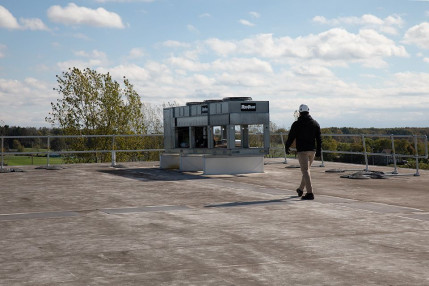Crucial Role of Guardrails for FISP Compliance in NYC

There are two things I think of first when New York City comes to mind. The bustling streets packed with such a diverse group of people and the gorgeous skyline adorned by skyscrapers.
What happens when you put these two together?
A need for safety.
One vital aspect of NYC’s safety framework is compliance with the Facade Inspection Safety Program (FISP), formerly known as Local Law 11.
In this article, I'm going to give a very high-level overview of FISP, review guardrail requirements through local building code, and show you a solution that will help you with your FISP reports.
What is FISP?

The Facade Inspection Safety Program increases requirements for the inspection and maintenance of exterior walls and appurtenances for required buildings.
This all started back in 1979 when a Barnard student, Grace Gold, was tragically struck and killed by falling debris. To avoid such tragedies from happening again, the NYC council updated the NYC building code to include facade inspections.
FISP applies to any building that is higher than six stories. Owners of such properties must have exterior walls and appurtenances inspected every five (5) years to keep buildings safe. They must file a technical facade report with the NYC Department of Buildings.
I’m not going to go over all the details of FISP, but here are a few key points you should know.
- The technical report needs to be submitted by a Qualified Exterior Wall Inspector (QEWI). There’s a lot that goes into being a QEWI and they will most likely be an engineer or architect in good standing with the relevant New York State departments, like the Department of Buildings.
- Owners are subject to violations and penalties if they do not follow and comply with FISP requirements.
- Reports will include results classified as safe, SWARMP, or unsafe as prescribed by the Code and Rule.
- Safe means no repair or maintenance is required, and the structure will not become unsafe in the next 5 years.
- SWARMP, or Safe with a repair and maintenance program, means that it is safe now but will require repair or maintenance in the next 5 years and not less than 1 year. If it is not taken care of, then SWARMP conditions immediately become unsafe during the next inspection.
- Unsafe means that the condition is hazardous and requires repairs within 1 year of the examination.
There is a lot more to FISP that I cannot go over here. However, there is one notable change in 2023 that I want you to be aware of.
Starting on January 1, 2024, every building owner must have an observation performed annually by a person competent to inspect parapets. This is for any building owner with parapets that front the public right-of-way, regardless of height.
These annual reports need to be kept for six years and provided upon request.
If you need more information about this and don’t want to scour documentation from the DOB, then contact NYC Facade Architecture, PLLC. They have years of experience working with these codes and can answer your questions, as well as perform the inspections.
What does Guardrail have to do with FISP?

Guardrail and FISP connect in the classification of unsafe.
During inspection, the QEWI is responsible for checking the parapets, facade, and anything attached to the parapet. This would include guardrail. If the guardrail doesn’t look safe, then that will go into the report and need to be addressed. Also, if you lack the appropriate fall protection, the QEWI could mark this as unsafe.
The QEWI would use NYC Building Code to determine what is and is not safe. Here is a quick rundown of what is required in NYC Building Code.
- Guardrails are required when roof access or mechanical equipment is within 10 feet of the roof edge and the fall is 30 inches or more.
- Guardrails (or equivalent like parapets) are required on buildings that are 22 feet in height with a slope less than 2.4 / 12.
- Guardrails need to be 42 inches in height.
- Guardrails should withstand 50 pounds per linear foot and a 200-pound concentrated load.
- Guardrails cannot allow a 4-inch sphere to pass through
- Exception: guardrails for mechanical use with no public access cannot have an opening that allows a 21-inch sphere to pass through
There is more detail and exceptions listed that you could find in the NYC building codes. Please connect with our experts to help you sort through your code required needs for fall protection.
Choosing the Right Guardrail Solution for FISP

When it comes to deciding what you should do about guardrails on your high-rise buildings, there are a few things to consider.
You want to ensure that any guardrail you choose will meet the building code requirements. This may seem simple, but OSHA compliant does not mean NYC building code compliant. Ask specific questions about how the guardrail you choose will meet the specific required standards that apply to you.
High-rise means exposure to high winds. Find out how the guardrail is going to withstand the winds at your building’s specific location and your rooftop’s height. The location does matter because surrounding buildings and other factors will affect how the wind impacts the guardrail.
It may seem wise to find a parapet mounted guardrail and call it a day. To be fair, this may be the right solution for you. However, consider that every connection onto the parapet is a potential failure point for future inspections. Find a guardrail system that can reduce or eliminate the need for parapet connections.
It is important to remember that 1 RCNY §103-04 Chapter 100 3 (G) says that guards need to be positively secured against movement. This may mean that the non-penetrating guardrail that you choose will need a few connections (most likely on each end) to meet this requirement. However, 2 connections are much better than 200.
Kee Guard Rooftop Guardrail for FISP

Kee Guard rooftop guardrail is what we advise you to use when your parapets are not meeting building code requirements for guards.
It’s non-penetrating, which means fewer penetrations on your roof or parapet.
It can be customized to meet the load requirements that are specific to your site, including engineered wind calculations that match your address.
It uses Kee Klamp fittings that allow it to flow across unique corners and obstacles on your roof, offering continuous fall protection.
All the components are hot-dipped galvanized for long term use and durability. This means it will last for multiple 5-year FISP inspections.
The counterweights are made from recycled PVC, helping with any of your green initiatives. Also, the weights are only 30 pounds, distributing the weight across a larger footprint on the roof. This way you don’t have depressions in your roof from heavy weights where water can pool.
These are just a few reasons why we suggest Kee Guard for your rooftop.
Your Next Steps
It’s important that you schedule your annual inspections for parapet observations. You can contact NYC Facade Architecture, PLLC to help you with that and your 5-year FISP inspection.
Ask them about how Kee Guard can help your rooftop be safe and compliant. Also, connect with our experts about Kee Guard, local code requirements, and OSHA standards. We’re here to help you stay safe and compliant.



